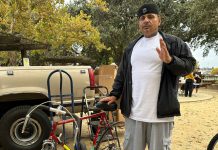Without volunteers, the annual three-day Christmas Hill Park
shindig honoring the reeking rose could never possibly be put on.
The time, talent and energy that more than 4,000 volunteers
contribute make up the heart and soul of the world’s most
famous food festival.
Without volunteers, the annual three-day Christmas Hill Park shindig honoring the reeking rose could never possibly be put on. The time, talent and energy that more than 4,000 volunteers contribute make up the heart and soul of the world’s most famous food festival.
This being Gilroy Garlic Festival weekend, I’d like to talk about an idea I truly believe has much merit for our troubled world: Volunteers make every community a better place for everyone.
Of course, the Garlic Festival isn’t the only local event that needs volunteers. There are many other worthwhile causes in the South Valley where people help out. The many groups that need unpaid workers fit all kinds of interests and descriptions.
I myself am involved with several nonprofit organizations – particularly groups involved with the preservation of the environment. Overall, my experiences volunteering have been positive ones.
The first time I ever volunteered for some kind of community service was back in high school. Well … I can’t actually call it “volunteering.” During my senior year at Palma High in Salinas, I and fellow classmates were required to spend an hour every day for four months helping out nonprofit organizations.
Picking a slip of paper out of a hat, I groaned when I read the description of my service obligation. I found myself situated with a class of learning-challenged third-graders at Salinas’s Roosevelt Elementary School. Grumbling, I was in no way thrilled by the prospect of working with snotty-nosed brats who had special education difficulties.
But by the end of the first week of my community service class, I realized it wasn’t as bad as I’d first thought. I seemed to have a natural connection with the kids. In fact, I made three of the children my special projects in trying to get them over their learning hurdles. I looked forward to my daily hour helping them.
Sitting in the kiddie chairs at low tables and tutoring the whippersnappers with their reading and math problems, I found that more often than not, I had to be a bit of a counselor in helping them deal with some of their emotional difficulties involving their home lives. I learned that kids often have it really rough in life.
When the time for my Roosevelt School service requirement came to an end, I felt sorry to part with the kids. I got many lesson out of the experience, but the most important one was realizing the fact that community service isn’t a chore. It’s a lot of fun. Once you have the right attitude, it can be a genuine joy to serve other people.
That’s what Thomas Kinkade wants to share in his newly published book “Points of Light: A Celebration of the American Spirit of Giving.” The internationally famous artist – who has connections to South Valley because he based his company headquarters in Morgan Hill – truly believes that volunteers are rewarded beyond measure for their generous service. He serves as the “National Ambassador of Light” spokesman for the Points of Light Foundation, an organization promoting throughout America the ideals of giving and service.
The payoffs to the volunteer aren’t necessarily material bounty, Kinkade says. The true treasures are the spiritual riches that service gives the human heart. One of these treasures is a greater sense of compassion and empathy for our fellow mortals.
A dedication to service can also change your view of the world and make you see tomorrow with a greater sense of hope, Kinkade believes. “If you start your day in a spirit of giving, you will begin to fan the flames of service and see every encounter in a new way, as an opportunity to share the light,” he writes.
At the end of “Points of Light,” Kinkade relates a simple story of a Florida woman named Charlotte Terry who was rewarded with a “miracle” after taking time to help a fellow human being in distress. The lesson of the little story is, in Terry’s words, “We’re all interconnected. If you do something good for someone else, it will come back to you.”
The more I volunteer, the more I believe that is a fact. Even though many times I don’t “feel” like going out of my way to help others, when I do, I usually gain something valuable out of the effort. In some mysterious way, it stretches my soul.
An example of this happened this week. One of my neighbors caught me as I stepped out of my townhouse for a 6am jog. His car was out of gas, and he desperately needed a ride to his work in an industrial park on the northern side of Morgan Hill.
“OK,” I told him. “I’ll take you.” But my heart wasn’t in it. All I wanted to do was go for my run – not serve as an early-morning chauffeur.
It took only five minutes to drop him off at his job. As I – grumbling – drove back home, I happened to pass the Thomas Kinkade headquarters near my neighbor’s place of employment. And that reminded me of the message in “Points of Light.” Its author Kinkade says that opportunities for service to others often happen at the most inconvenient times and places, “but it’s the very inconvenience that makes our response so meaningful.”
With that in mind, a grin crossed my face. The simple object lesson hit me. Perhaps the opportunity to help out my neighbor had been no mere accident. Perhaps it was the universe trying to tell me that I – and everyone else – was put on this planet to serve others.
Like Thomas Kinkade, I believe that if we all can exchange our selfish “what’s-in-it-for-me?” philosophy for a “how-can-I-be-of-service?” attitude, we will be taking a huge step toward making our planet a much better place for everyone. Whether it be at the Gilroy Garlic Festival this weekend or helping out a neighbor in need at any time, volunteers make a big difference in creating a better world.














